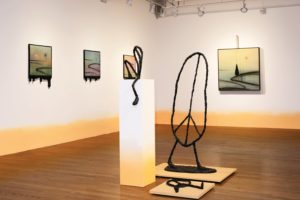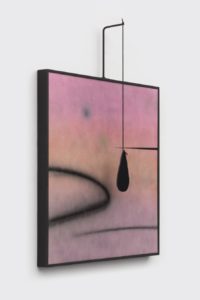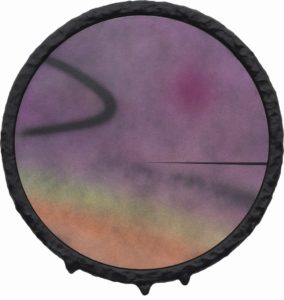Wendy White wants to know why painting is held in such high esteem compared to other art forms. “I’m a little skeptical about whether all those accolades are fair. It’s just a bunch of marks, whether it collects into an image or doesn’t,” says the New York artist whose exhibition “Sunset Drift” is currently at Gaa Gallery. “A lot of my work is about pushing painting away.”

These might seem like surprising words for an artist well known in the world of contemporary painting. Yet it’s precisely this attitude that gives White the freedom to expand the medium into new territory.
White’s works on view at Gaa extend beyond the confines of static rectangular surfaces, though they still read as paintings.
A series of atmospheric paintings that seem to reference a seascape at twilight are framed by oozing black material. Others in the series are interrupted by teardrop shapes that hang in front of them and project wavering shadows onto the canvas. The colors of her paintings reverberate in the bottom edge of the walls, which White painted in sunset orange. Even the sculptures, anthropomorphized peace signs, seem to be part of the paintings. White intended for the black substance to feel as if it “collected into a walking peace sign” and then became “disembodied and recollected onto a frame.”
White’s work gained critical attention in the late aughts with a series of shows at Leo Koenig Gallery in New York. Her early multipanel paintings evoked graffiti with their scrawling spray-painted gestural marks and bits of text, some of which stood as three-dimensional elements on the tops or sides of the paintings.
The critic Raphael Rubinstein identified her work as part of a movement of “provisional painting,” work that “deliberately turns away from ‘strong’ painting for something that seems to constantly risk inconsequence or collapse.” Although White distances herself from some of the ironic intent of provisional painting, her skepticism toward the vaunted status of painting is very much of our time, one when painting defined as an earnest tradition learned at the feet of great masters feels antiquated.

White finds inspiration in diverse places: clip art, peace signs, and works by Alexander Calder, the 20th-century sculptor. In 2016, White began making suspended sculptural pieces of simple images of clouds, hearts, and raindrops. “All these things we associate with weather but also could represent emotions or a state of being,” White says.
Last year, White began considering how to merge the suspended pieces with her paintings and found a strategy after visiting a Calder show at the Museum of Modern Art. In particular, she was impressed by two prototypes he had made in the late ’30s. The pieces, featuring mobiles hanging off the front of painted Masonite boards, “became this play on two-dimensional and three-dimensional space,” says White. “I need to build an armature so I can suspend one of these things and control the space in which it’s viewed,” she recalls thinking.
Two square paintings in her exhibition embody this idea. In Dripping Green (After Calder) and Dripping Pink (After Calder), White places a hook-shaped metal armature atop a framed painting. On it, a black shape hangs into the space a few inches from the painting’s surface. The work charts new territory for her and also reflects a juxtaposition she likes: “It’s always about something hard and something soft, something atmospheric and something graphic. What happens when those two things meet and share space?”

The play of shadow on the canvas and the integration of sculptural elements feel both exciting and transgressive. A painting purist would likely object to the way the painting is interrupted by external elements as well as to the formulaic way White composes the pictures. “ ‘Painting purity’ just isn’t really in my DNA,” she says.
Working almost exclusively with an airbrush, White uses a restrained tool kit of moves: a gradation of color, a circular dot, a swooping gestural mark, and a thin, hard-edged triangular shape. “With this series, the painting part needed to take a secondary role to the space and the object and just be a player,” says White.
The work looks casual. But that doesn’t mean it is, White says. “I feel like my work has always been misunderstood as being super fun and synthetic,” she says, though “I’ve always been really serious about art making and serious about content.”
The viewer isn’t always sure if the works in this show are light or heavy. White says she intended the show to capture Provincetown’s beachy vibe. She has been coming to Provincetown for years, since participating in a DNA Artist Residency — a program led by gallerist Nick Lawrence that brings artists here for short stays in the summer.
Riffs on sunset themes are also part of White’s style: she dyes her hair pink and drove to Provincetown in a gleaming 1972 Plymouth Scamp. Although she grew up in Deep River, Conn. — a “gray New England” town — she says she has always had “this crazy fascination with California.”

But among the buoyant notes are darker themes, evidenced in the heavy black material and pathetically humorous peace signs.
“There’s still a depth and a dark side to this body of work because of the times we’re in,” she says. Whereas others might locate the sublime within sunrises and sunsets, for White, they point toward a moment of loss and transition, something she describes as “conceptually on point with the sociopolitical, cultural, and collective emotional moment.
“Meaning for me is always on the periphery,” White says. While seriousness might not be on the surface of her work, it lurks not far beneath.
Outside the Frame
The event: “Sunset Drift,” an exhibition of paintings and sculpture by Wendy White
The time: Through Aug. 1
The place: Gaa Gallery, 494 Commercial St., Provincetown
The cost: Free



